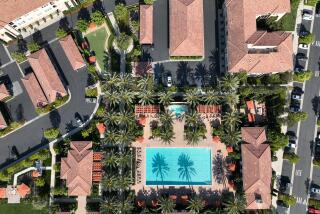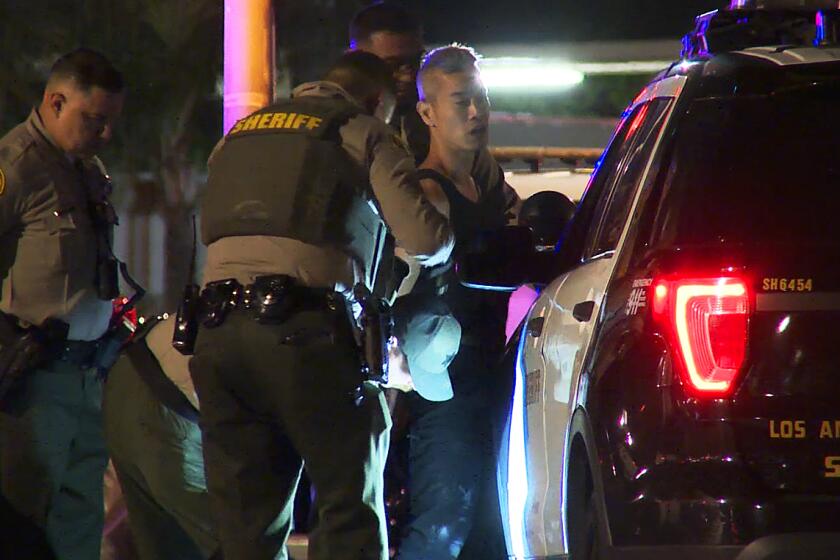The Battle of L.A. turns 75: When a panicked city fought a Japanese invasion that never happened
This week marks the 75th anniversary of the Battle of Los Angeles, one of the scarier and more absurd moments in the city’s World War II efforts.
Following the Dec. 7, 1941, attack on Pearl Harbor, war jitters swept the Southland. By February 1942, air-raid sirens, searchlights and antiaircraft guns filled Los Angeles. Blackouts and drills were common.
Then on Feb. 23, 1942, a Japanese submarine surfaced and shelled oil installations at Ellwood, north of Santa Barbara.
Longtime Times columnist and Los Angeles observer Jack Smith explains what happened next in a February 1992 column:
It was on the night of Feb. 25, 1942, that Los Angeles experienced the Great Los Angeles Air Raid. It was a night when everyone’s fears apparently were realized — Japan had brought the war to mainland America, and Los Angeles was the target.…
The Great Air Raid began at 2:25 a.m. on that clear moonlit night when the U.S. Army announced the approach of hostile aircraft, and the city’s air raid warning system went into action for the first time in the war.
Suddenly, the night was torn by sirens. Searchlights swept the sky. Gun crews at army posts along the coastline began pumping ack-ack into the moonlight. (In the entire episode, 1,433 rounds would be fired.)
Thousands of volunteer air-raid wardens tumbled from their beds and grabbed their boots and helmets — those who had helmets — and rushed into the night. Tens of thousands of citizens, awakened by the screech of sirens and the popping of shells, jumped out of bed and, heedless of blackout regulations, began snapping on lights. It was pandemonium. …
Although no bombs were dropped, the city did not escape its baptism of fire without casualties, including five fatalities. Three residents were killed in automobile accidents as cars dashed wildly about in the blackout. Two others died of heart attacks.
Several persons were injured hurrying to their various posts. A radio announcer ran into an awning and suffered a gash over one eye. A police officer kicked in the window of a lighted Hollywood store and cut his right leg. ...
There was scattered structural damage caused by antiaircraft shells that failed to explode in air but did so when they struck the ground, demolishing a garage here, a patio there, and blowing out a tire on a parked automobile.
Exultation was in the air. The city had met its first taste of war with valor. It was exhilarating. But exultation turned to embarrassment the next day when the Secretary of the Navy said there had been no air raid. No enemy planes. It was just a case of jitters.
Embarrassment turned to outrage. The army was accused of shooting up an empty sky. The sheriff was particularly embarrassed. He had valiantly helped the FBI round up several Japanese nurserymen and gardeners who were supposedly caught in the act of signaling the enemy aviators.
The Secretary of War tried to save face by saying that while there were no enemy aircraft in the air, it was believed that 15 commercial planes flown by “enemy agents” had crossed the city. Though no one believed this gross canard, most agreed with the secretary that “it is better to be too alert than not alert enough.”
At war’s end, an Army document explained what had happened: (1) numerous weather balloons had been released over the area that night. They carried lights for tracking purposes, and these “lighted balloons” were mistaken for enemy aircraft; (2) shell bursts illuminated by searchlights were mistaken by ground crews for enemy aircraft.
The Japanese, after the war, declared that they had flown no airplanes over Los Angeles on that date. All the same, it was a glorious night, and I commend its memory to those who think Los Angeles has no history.
The Battle of Los Angeles speaks to what fear can do in wartime.
This month also marks the 75th anniversary of Japanese internment. President Franklin D. Roosevelt signed Executive Order 9066, which paved the way for the incarceration of 120,000 Japanese Americans — many from California — in internment camps.
A year later in 1943, Los Angeles witnessed the so-called Zoot Suit riots, when roving gangs of U.S. servicemen attacked and stripped Mexican Americans they spotted wearing the ornately tailored zoot suits.
Internment and the Zoot Suit riots are now cited by historians as grim examples of how panic and mob rule can take hold in times of war.
The Battle of Los Angeles was played for laughs in the Steven Spielberg movie “1941,” which was based on the scare and starred Dan Aykroyd, John Belushi and John Candy, among others.
The movie poster of the 1979 film hailed it as “A Comedy Spectacular.”
ALSO
In a corner of Orange County, a dark chapter in history: the Japanese American internment
Editorial: 75 years later, looking back at The Times’ shameful response to the Japanese internment
More to Read
Start your day right
Sign up for Essential California for news, features and recommendations from the L.A. Times and beyond in your inbox six days a week.
You may occasionally receive promotional content from the Los Angeles Times.






